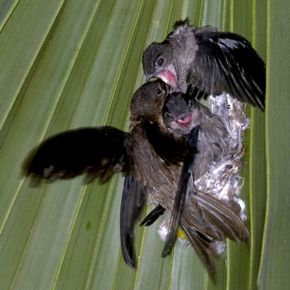TS Tan’s image shows an adult Asian Palm Swift (Cypsiurus balasiensis) feeding two hungry chicks late one evening in May 2010. This family is among a colony roosting and nesting in a fan palm (Livistona sp.) growing right next to a busy road and a two storey building in Singapore.
The Asian Palm Swift is a common resident in Singapore. It is also commonly seen around other palms like toddy (Borassus), betel nut (Areca) and talipot (Corypha) that they use for roosting and nesting.
The nest is a flimsy half-cup attached to the undersurface of an older palm frond that hangs down almost vertically. Plant floss, usually from the silk cotton tree (Ceiba pentandra), bulrush (Typha spp.), etc. are used to construct the nest. Feathers may also be used. The nesting materials are glued to the palm surface with the help of the birds’ saliva.
In other species, the eggs are glued to the nest as otherwise they may get dislodged during stormy weather when the palm fronds get blown by the strong wind. However, the eggs of the Asian Palm Swift are not glued to the nest. Besides having a deeper egg chamber, the eggs are incubated continuously during such weather.
Note that one of the chicks is inside the nest while the other is perched at the apron during the feeding. Obviously there is not enough space in the nest as the chicks are at an advanced stage of development. Notice also their well-developed wing feathers. And as with most chicks, they have a reddish gape.









